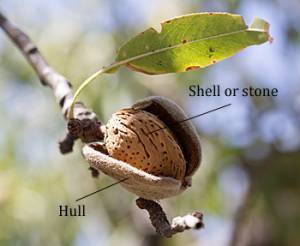Almond Hulls: Soluble Fiber for Horses

Almond hulls have withstood scientific scrutiny as a source of energy when fed to dairy cows, beef cattle, lambs, and hogs. On the contrary, little research has been done on their potential as a feedstuff for horses, but interest in almond hulls is waxing.
While most people are familiar with the almond seed—what we commonly call the nut—few might realize that, as the almond is growing, the seed is encased in a pitted shell, which is further protected by a fuzzy hull. As almonds mature, the hull changes color from pea-green to pale yellow. The hull splits and slowly unseals until, at peak maturity, it is wide-open, exposing the dried shell within and simplifying harvest.
A study conducted at California State University, Fresno, in the early 1990s verified almond hulls as a safe and palatable feed for horses when it accounted for as much as 45% of the ration. No negative side effects were noted.1 After this study, however, little research on the usefulness of almond hulls in equine diets occurred until recently.
Researchers at the University of Florida set out to determine if almond hulls, with their rich soluble fiber content, would reduce or delay glucose and insulin responses in horses.2 Horses were fed diets containing orchardgrass hay or orchardgrass hay with one of three treatments: molassed sugar beet pulp, almond hulls, or steam-crimped oats. Once adapted to the diets, blood was serially sampled to determine glycemic and insulinemic responses of the diets. Serum insulin was lower in the horses fed hay alone or with almond hulls compared with those fed beet pulp and oats.
The researchers hypothesized that there was little difference in glycemic and insulinemic responses between orchardgrass hay and almond hulls because the horses were very slow in consuming the almond hulls. Time of consumption appears to have a greater influence on glucose and insulin than nonstructural carbohydrate (NSC) content of the feed.
 While we may think of almonds as nuts, botanists consider them “drupes,” fleshy fruits characterized by a thin skin and a central stone that contains a seed. Other examples are cherries and plums. The hull (skin) and stone (shell) of an unharvested almond are shown in this image. Almond hulls are low in crude protein, containing 3-5%.3 They have the energy equivalent of early- to mid-bloom alfalfa hay, which would classify them as a super-fiber.1 The United States grows more almonds than any country in the world, nearly two million tons, and California is the epicenter of production.4
While we may think of almonds as nuts, botanists consider them “drupes,” fleshy fruits characterized by a thin skin and a central stone that contains a seed. Other examples are cherries and plums. The hull (skin) and stone (shell) of an unharvested almond are shown in this image. Almond hulls are low in crude protein, containing 3-5%.3 They have the energy equivalent of early- to mid-bloom alfalfa hay, which would classify them as a super-fiber.1 The United States grows more almonds than any country in the world, nearly two million tons, and California is the epicenter of production.4
1Clutter, S.H., and A.V. Rodiek. 1992. Feeding value of diets containing almond hulls. In: Proceedings of the Equine Nutrition and Physiology Society 12(2):99-102.
2Hansen, T.L., E.M. Rankins, J.M. Bobel, M. McKinney, T.J. Hackmann, and L.K. Warren 2020. Postprandial blood glucose and insulin responses of horses to feeds differing in soluble fiber concentration. Journal of Equine Veterinary Science. In press.
3Dairy One, Inc. Interactive feed composition libraries. Accessed 18 March 2020.
4United States Department of Agriculture. National Agricultural Statistics Service. Accessed 18 March 2020.
Image provided by Antonio Jose Cespedes from Pixaby.








